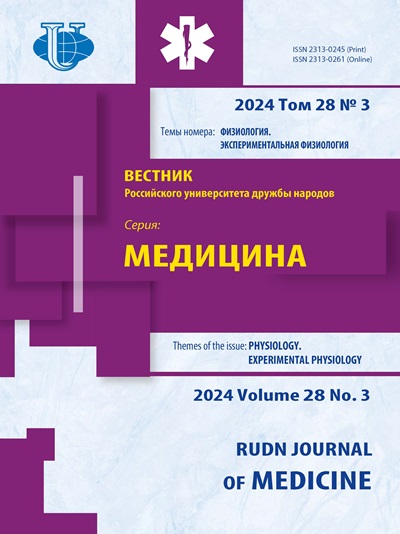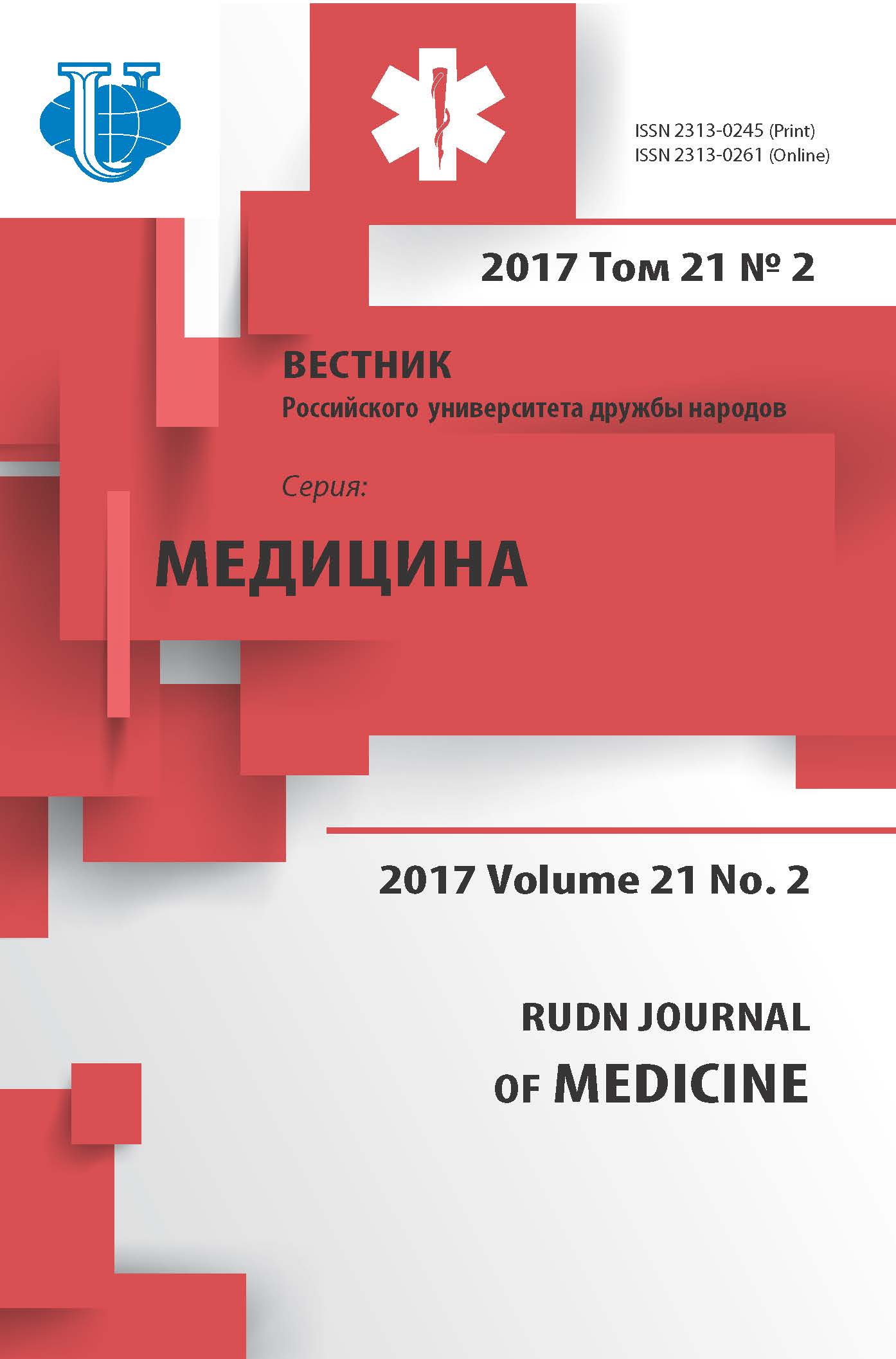THE ROLE OF INTRAVASCULAR METHODS OF RESEARCH TO VERIFY THE DIAGNOSIS OF CORONARY HEART DISEASE IN WORKERS OF JSC “RUSSIAN RAILWAYS” RELATED TO THE SAFETY OF TRAIN TRAFFIC
- Authors: Prishchep OA1, Maksimkin DA1, Shugushev ZK.1,2
-
Affiliations:
- FSAEI of HE “Peoples’ Friendship University of Russia”
- N.A. Semashko Central Clinical Hospital No 2, JSC “Russian Railways”
- Issue: Vol 21, No 2 (2017)
- Pages: 246-258
- Section: Articles
- URL: https://journals.rudn.ru/medicine/article/view/16645
- DOI: https://doi.org/10.22363/2313-0245-2017-21-2-246-258
Cite item
Full Text
Abstract
The purpose of the study was to determine the role of the complex use of FFR and IVUS to verify the diagnosis of coronary heart disease in the examination of the professional suitability of Russian Railways employees, related to safety of train traffic. The study showed that survival rates free of major adverse cardiac events, transient rhythm disturbances, syncopal conditions and repeated hospitalizations for the angina pectoris, in groups with “unchanged” coronary arteries and intermediate stenoses of the coro-nary arteries with FFR negative result were not significantly different in the long-term period and amounted to 100 and 95.2%, respectively (p > 0.05), which makes to consider them as professionally suitable workers and return to work. When comparing this indicator in the subgroups of patients with FFR positive result undergoing stenting under the control of IVUS and patients with FFR negative result receiving optimal medical therapy, there were also no significant differences (97.3 and 95.2%, respectively, p > 0.05), which makes it possible to swich workers who have undergone stenting to "light" work, not related to the safety of train traffic.
About the authors
O A Prishchep
FSAEI of HE “Peoples’ Friendship University of Russia”
Author for correspondence.
Email: wolkova.o@gmail.com
аспирант кафедры госпитальной хирургии с курсом детской хирургии РУДН
D A Maksimkin
FSAEI of HE “Peoples’ Friendship University of Russia”
Email: konovalov_oe@rudn.university
Z Kh Shugushev
FSAEI of HE “Peoples’ Friendship University of Russia”; N.A. Semashko Central Clinical Hospital No 2, JSC “Russian Railways”
Email: konovalov_oe@rudn.university
References
- Corporate social responsibility report of JSCo “RZD” — 2013. [Electronic resource]. Access mode: http://rzd.ru/static/public/ru?STRUCTURE_ID=5085. Date of access: 06.07.2016.
- Polkhov V. & Shashkov A. The quality management system of medical maintenance of traffic safety in JSC “Russian Railways”. Meditsina: tselevye proekty. 2014. № 19. P. 24—28 (In Russ.).
- The activity of non-governmental healthcare institutions of JSC “RZD” in 2015. Collection of sta-tistic materials. 2016. 275 p.
- Purpose-oriented comprehensive program to reduce the incidence and prevention of cardiovascular mortality of employees of OJSC “Russian Railways” for the period 2015—2017. [Electronic re-source] Access mode: http://nuz-vologda.ru/files/programma_RZD_2015-2017.pdf. Date of ac-cess: 25.02.2017.
- About the statement of the list of medical contraindications to the works directly related to the trains traffic and shunting work: the order of the Ministry of Health and social development of the Russian Federation from December, 19th, 2005 № 796. [Electronic resource] Access mode: http://docs.cntd.ru/document/901963040. Date of access: 25.02.2017.
- Montalescot G., Sechtem U., Achenbach S., et al., Task Force Members. 2013 ESC guidelines on the management of stable coronary artery disease: the Task Force on the management of stable coronary artery disease of the European Society of Cardiology. Eur Heart J. 2013. № 34. P. 2949—3003.
- Levine G.N., Bates E.R., Blankenship J.C., Bailey S.R., et al. 2011 ACCF/AHA/SCAI guideline for percutaneous coronary intervention: a report of American college of cardiology founda-tion/American heart association task force on practice guidelines and the society for cardiovascular angiography and interventions. Circulation. 2011. № 124. P. 574—651.
- Ivanov V.A, Movsesjanc M.Ju. & Bobkov Ju.A. Intravascular methods of diagnosis in intervention cardiology. Moscow: Medpraktika-M. 2008. 268 p. (In Russ.).
- Kohan E.P., Ivanov V.A., Movsesjanc M.Ju. et al. Integral methods of state estimation of blood flow to determine the tactics of the coronary intravascular interventions. Mezhdunarodnyj zhurnal intervencionnoj kardioangiologii. 2007. № 12. С. 45—49. (In Russ.).
- Berry С., Corcoran D., Hennigan B., Watkins S., Layland J. & Oldroyd K.G. Fractional flow re-serve-guided management in stable coronary disease and acute myocardial infarction: recent de-velopments. Eur Heart J. 2015. V. 36. № 45. P. 3155—3164.
- Pijls N. H. J, van Schaardenburgh P., Monoharan G. et al. Precutaneous coronary intervention of functionally nonsignificant stenosis: 5-year follow-up of the DEFER study. J. Am. Coll. Cardiol. 2007. V. 49. № 21. Р. 2105—2111.
- Toth G., Hamilos M., Pyxaras S., Mangiacapra F., Nelis O., De Vroey F., Di Serafino L., Muller O., Van Mieghem C., Wyffels E., Heyndrickx G.R., Bartunek J., Vanderheyden M., Barbato E., Wijns W. & De Bruyne B. Evolving concepts of angiogram: fractional flow reserve discordances in 4000 coronary stenoses. Eur Heart J. 2014. V. 35. № 40. Р. 2831—2838.
- Cho H.O., Nam C.W., Cho Y.K., Yoon H.J., Park H.S., Kim H., Chung I.S., Doh J.H., Koo B.K., Hyun D.W., Hur S.H., Kim Y.N. & Kim K.B. Characteristics of function-anatomy mismatch in patients with coronary artery disease. Korean Circ J. 2014. V. 44. № 6. P. 394—399.
- Pijls N.H., Fearon W.F., Tonino P.A., Siebert U., Ikeno F., Bornschein B., van't Veer M., Klauss V., Manoharan G., Engstrøm T., Oldroyd K.G., Ver Lee P.N., MacCarthy P.A. & De Bruyne B. FAME Study Investigators. Fractional flow reserve versus angiography for guiding percutaneous coronary intervention in patients with multivessel coronary artery disease: 2-year follow-up of the FAME (Fractional Flow Reserve Versus Angiography for Multivessel Evaluation) study. J Am Coll Cardiol. 2010. V. 56. № 3. Р. 177—184.
- De Bruyne B., Pijls N.H., Kalesan B., Barbato E., Tonino P.A., Piroth Z., Jagic N., Möbius-Winkler S., Rioufol G., Witt N., Kala P., MacCarthy P., Engström T., Oldroyd K.G., Mavro¬matis K., Manoharan G., Verlee P., Frobert O., Curzen N., Johnson J.B., Jüni P. & Fearon W.F. FAME 2 Trial Investigators. Fractional flow reserve-guided PCI versus medical therapy in stable coronary disease. N Engl J Med. 2012 V. 367. № 11. Р. 991—1001.
- Park S.J., Ahn J.M., Park G.M., Cho Y.R., Lee J.Y., Kim W.J., Han S., Kang S.J., Park D.W., Lee S.W., Kim Y.H., Lee C.W., Mintz G.S. & Park S.W. Trends in the outcomes of percutaneous coronary intervention with the routine incorporation of fractional flow reserve in real practice. Eur Heart J. 2013. V. 34. P. 3353—3361.
- Li J., Elrashidi M.Y., Flammer A.J., Lennon R.J., Bell M.R., Holmes D.R., Bresnahan J.F., Rihal C.S., Lerman L.O. & Lerman A. Long-term outcomes of fractional flow reserve-guided vs. an-giography-guided percutaneous coronary intervention in contemporary practice. Eur Heart J. 2013. V. 34. P. 1375—1383.
- Windecker S., Kolh P., Alfonso F., Collet J.P., et al. 2014 ESC/EACTS Guidelines on myocardial revascularization: The Task Force on Myocardial Revascularization of the European Society of Cardiology (ESC) and the European Association for Cardio-Thoracic Surgery (EACTS) Devel-oped with the special contribution of the European Association of Percutaneous Cardiovascular Interventions (EAPCI). Eur Heart J. 2014. V. 35. № 37. P. 2541—2619.
- Waksman R., Legutko J., Singh J., et al. FIRST: Fractional Flow Reserve and Intravascular Ultra-sound Relationship Study. J Am Coll Cardiol. 2013. 61. P. 917—923.
- Stone G.W., Maehara A., Lansky A.J., et al. A prospective natural-history study of coronary atherosclerosis. N Engl J Med. 2011. № 364. P. 226—235.
- Tagieva N.R., Shakhnovich R.M. et al. Prognostic value of the characteristics of atherosclerotic plaques in the coronary arteries in patients with acute myocardial infarction and chronic ischemic heart disease according to the intravascular ultrasound. Ateroskleroz i dislipidemii. 2015. № 4. P. 25—29 (In Russ.).
- Chukaeva I.I., Ahmatova F.D., Koledinskij A.G., Abil'dinova A.Zh. & Rogatova A.N. A vul¬nerable atheromatous plaque: New possibilities of intracoronary visualization. Mezhduna¬rodnyj zhurnal intervencionnoj kardioangiologii. 2010. № 22. P. 45—51 (In Russ.).
















